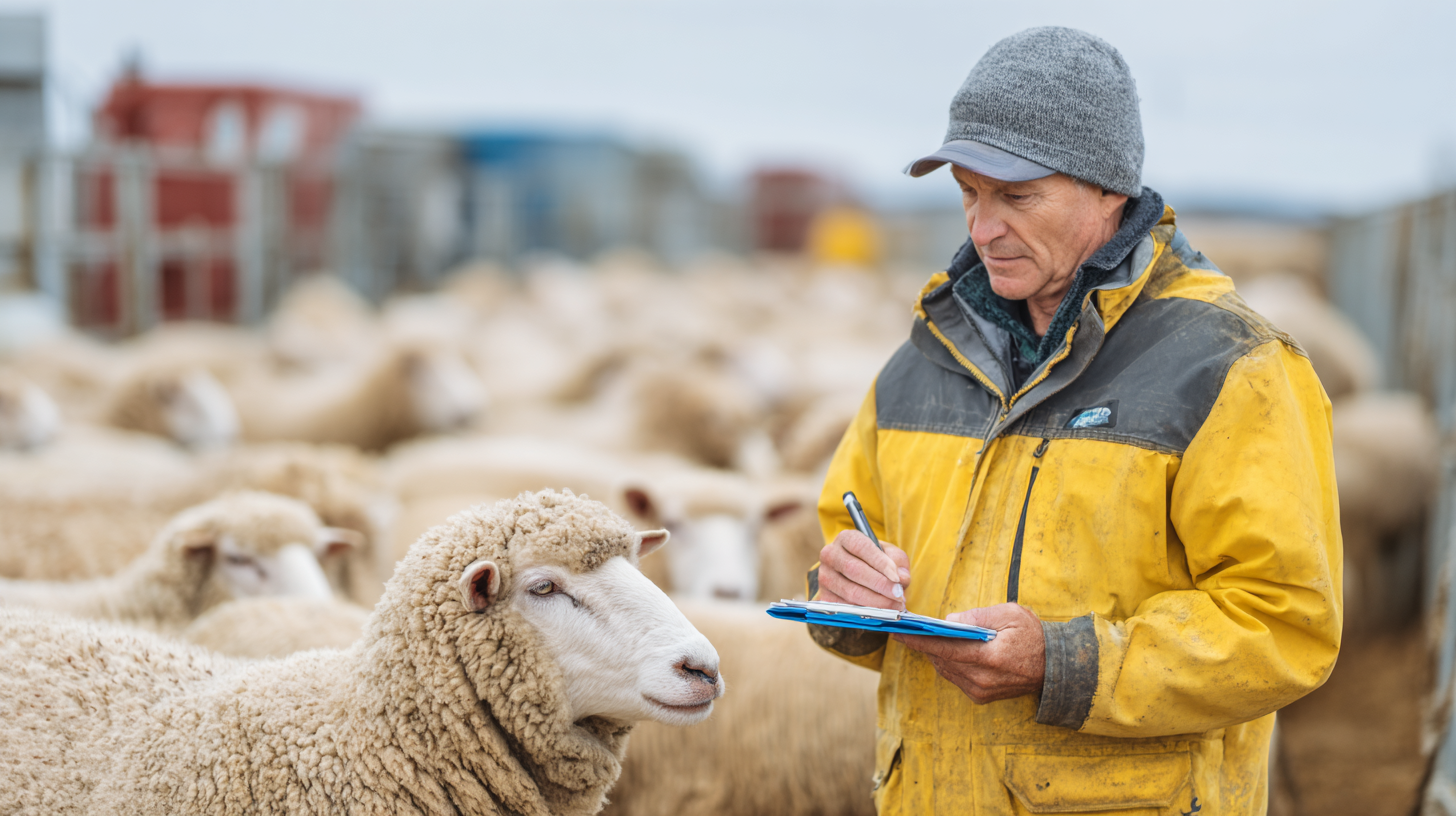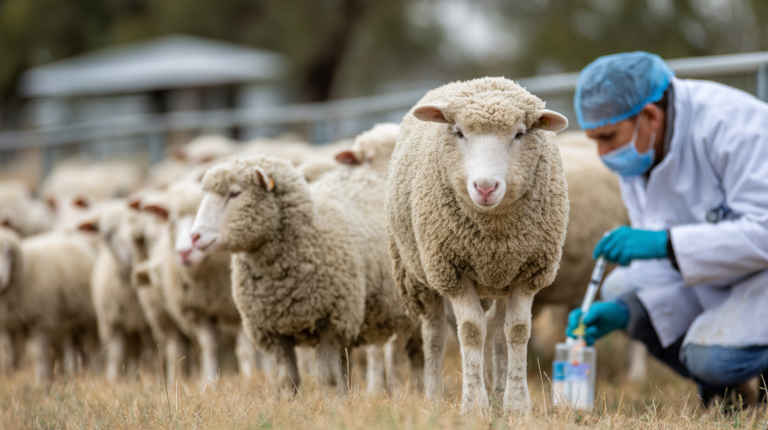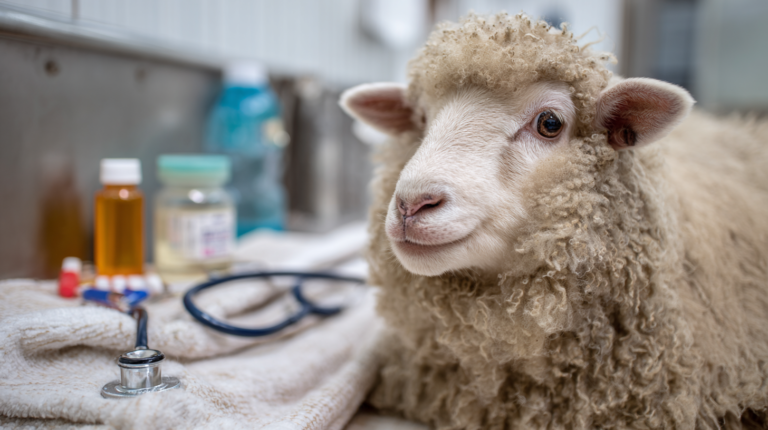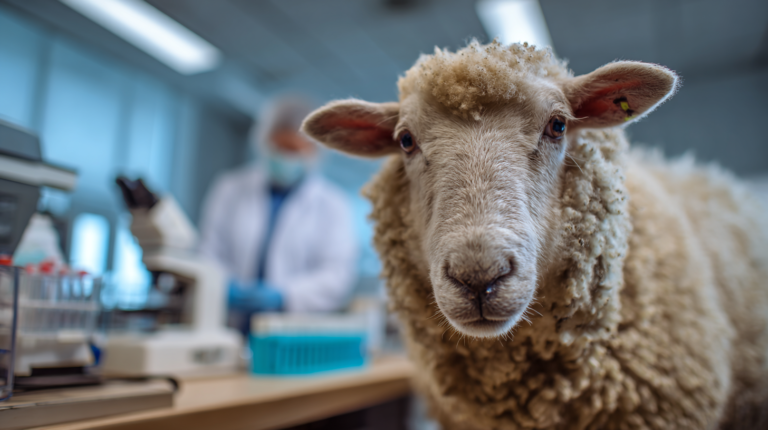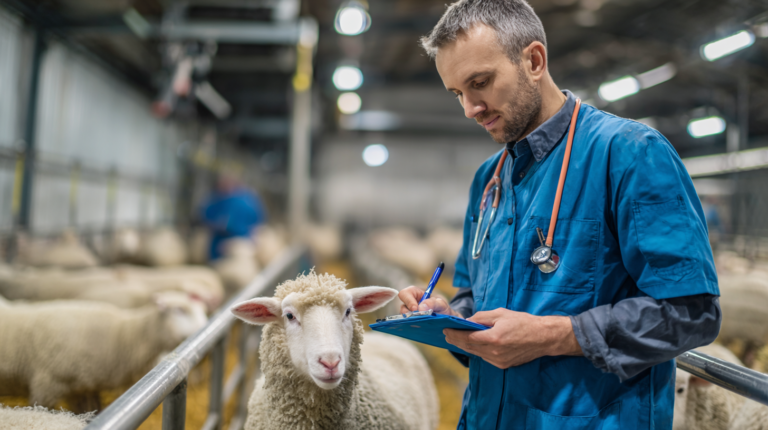Discover the 7 critical signs of internal parasites in sheep including anemia, diarrhea, weight loss, and bottle jaw. Learn FAMACHA scoring and prevention strategies for healthy flocks.
Table of Contents
Internal parasites in sheep represent one of the most significant health challenges facing sheep owners worldwide. These microscopic invaders can devastate flock health, reduce productivity, and in severe cases, lead to death if left untreated. Understanding the critical warning signs of parasitic infections is essential for every sheep owner, whether you’re managing a small backyard flock or a large commercial operation.
Parasitic infections affect an estimated 80-90% of sheep globally, making them a nearly universal concern in sheep husbandry. The economic impact is staggering – internal parasites cost the global sheep industry billions of dollars annually through reduced wool production, poor weight gain, decreased fertility, and increased mortality rates. However, with proper knowledge and vigilant monitoring, these devastating effects can be prevented or minimized.
This comprehensive guide will equip you with the knowledge to identify the seven most critical signs of internal parasites in sheep, understand the underlying causes, and take appropriate action to protect your flock’s health and wellbeing.
Understanding Internal Parasites in Sheep:
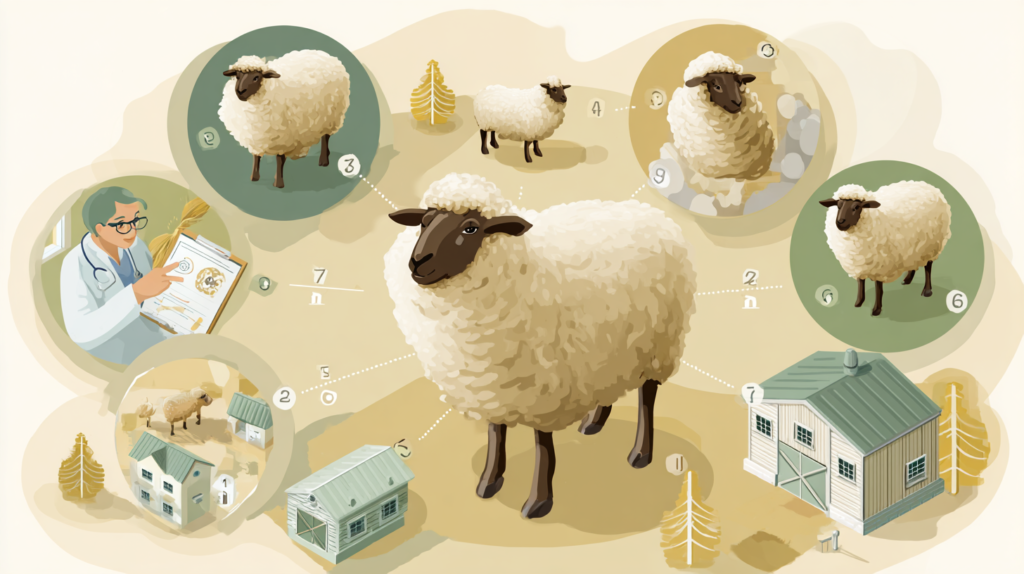
Internal parasites are organisms that live within a sheep’s body, primarily in the digestive system, though some affect other organs. The most common internal parasites affecting sheep include gastrointestinal nematodes (roundworms), tapeworms, liver flukes, and lungworms. Each type presents unique challenges and requires specific management approaches.
Gastrointestinal nematodes are by far the most prevalent and problematic internal parasites in sheep. The “big three” – Haemonchus contortus (barber pole worm), Teladorsagia circumcincta (brown stomach worm), and Trichostrongylus species – cause the majority of parasitic disease in sheep worldwide. These parasites have complex life cycles that involve both internal (within the sheep) and external (in the environment) phases.
According to Dr. Susan Schoenian, a sheep and goat specialist at the University of Maryland Extension, “Gastrointestinal parasites are the number one health problem affecting sheep and goats in the United States. They cause more economic losses than all other diseases combined.”
The life cycle of these parasites typically follows a predictable pattern: adult worms live in the sheep’s digestive tract, laying eggs that are passed in feces. Under favorable environmental conditions – warm temperatures and adequate moisture – these eggs develop into infective larvae. Sheep become infected when they ingest these larvae while grazing.
Understanding this cycle is crucial because it reveals why certain environmental conditions and management practices either increase or decrease infection risk. Wet, warm conditions accelerate larval development, while dry, hot conditions can kill larvae on pasture. This knowledge forms the foundation for effective parasite management strategies.
The Seven Critical Signs of Internal Parasites in Sheep
| Sign # | Critical Sign | Description & Key Indicators |
|---|---|---|
| 1 | Anemia & Pale Mucous Membranes | FAMACHA scoring reveals pale pink to white eyelid color, indicating blood loss from parasites like Haemonchus contortus |
| 2 | Diarrhea & Abnormal Fecal Consistency | Soft, loose, or watery stools with possible mucus or blood, indicating intestinal damage and inflammation |
| 3 | Weight Loss & Poor Body Condition | Significant reduction in body weight despite adequate feed availability, visible ribcage and spine prominence |
| 4 | Reduced Appetite & Eating Changes | Decreased feed intake, reluctance to eat, or changes in grazing behavior patterns |
| 5 | Rough, Dull Coat & Poor Wool Quality | Loss of natural shine, brittle texture, and overall deterioration in fleece condition and appearance |
| 6 | Swelling Under the Jaw (Bottle Jaw) | Fluid accumulation in submandibular area due to protein loss, creating characteristic swollen appearance |
| 7 | Respiratory Distress & Coughing | Labored breathing, persistent cough, or nasal discharge from lungworm infections affecting respiratory system |
1. Anemia and Pale Mucous Membranes (FAMACHA Scoring)
Anemia is perhaps the most critical and immediately life-threatening sign of internal parasites in sheep. This condition occurs primarily due to blood-sucking parasites, particularly Haemonchus contortus, which can consume up to 0.05 milliliters of blood per worm per day. In heavy infections, thousands of worms can drain a sheep’s blood supply rapidly.
The FAMACHA system, developed in South Africa, provides a standardized method for assessing anemia in sheep and goats. This system involves examining the color of the mucous membranes inside the lower eyelid, comparing it to a color chart with five categories ranging from red (healthy) to white (severely anemic).
Visual indicators of anemia include:
- Pale or white gums and inner eyelids
- Weakness and lethargy
- Difficulty standing or walking
- Rapid, shallow breathing
- Cold extremities (ears, legs)
FAMACHA scoring categories:
- Score 1 (Red): Healthy, no treatment needed
- Score 2 (Red-pink): Healthy, monitor closely
- Score 3 (Pink): Mild anemia, consider treatment
- Score 4 (Pink-white): Moderate anemia, treatment recommended
- Score 5 (White): Severe anemia, immediate treatment required
Research conducted by the American Consortium for Small Ruminant Parasite Control shows that sheep with FAMACHA scores of 4 or 5 have a significantly higher risk of death within 7-14 days if left untreated. This scoring system has become an invaluable tool for sheep owners to make informed treatment decisions and avoid unnecessary deworming.
Regular FAMACHA scoring should be performed every 2-3 weeks during high-risk periods (typically late spring through early fall) and monthly during lower-risk periods. This practice allows for targeted treatment of only the most severely affected animals, helping to preserve anthelmintic effectiveness and reduce the development of drug resistance.
2. Diarrhea and Abnormal Fecal Consistency
Diarrhea represents another critical sign of internal parasites in sheep, often indicating severe gastrointestinal damage or high parasite loads. While not all parasitic infections cause diarrhea, its presence – particularly when accompanied by other symptoms – should trigger immediate investigation.
Different parasites cause distinct types of diarrhea:
Trichostrongylus species typically cause dark, tarry diarrhea due to bleeding in the small intestine. These parasites damage the intestinal lining, leading to malabsorption of nutrients and electrolyte imbalances. The resulting diarrhea often has a characteristic dark appearance due to digested blood.
Nematodirus species cause watery diarrhea, particularly in young lambs. These parasites can multiply rapidly in favorable conditions, leading to explosive outbreaks that can affect entire lamb crops. The diarrhea is typically profuse and watery, leading to rapid dehydration.
Coccidiosis, while technically caused by protozoan parasites rather than worms, produces bloody diarrhea with mucus. This condition is particularly problematic in young, stressed, or immunocompromised animals.
Warning signs to monitor:
- Consistency changes from normal pelleted droppings to loose or watery stool
- Color changes, including dark, tarry appearance or bright red blood
- Mucus or abnormal texture
- Frequency changes in defecation
- Fecal staining around the tail and hindquarters
The severity and duration of diarrhea can indicate the parasite load and the urgency of treatment required. Acute, profuse diarrhea demands immediate attention, while chronic, mild diarrhea may indicate a more established infection requiring comprehensive management.
3. Significant Weight Loss and Poor Body Condition
Weight loss and poor body condition scoring represent cumulative effects of internal parasites in sheep and often indicate chronic, long-term infections. These signs may develop gradually, making them easy to overlook until they become severe.
Body condition scoring (BCS) uses a standardized scale from 1 to 5, where 1 represents emaciated animals and 5 represents obese animals. Ideal body condition for most sheep ranges from 2.5 to 3.5, depending on their production stage and breed.
Body condition scoring involves:
- Palpating the loin area behind the last rib
- Assessing fat cover and muscle development
- Evaluating the prominence of the backbone and ribs
- Observing overall body shape and muscle definition
Parasitic infections affect body condition through multiple mechanisms:
- Reduced feed intake due to gastrointestinal discomfort and nausea
- Impaired nutrient absorption from damaged intestinal lining
- Increased metabolic demands from immune system activation
- Protein loss through damaged intestinal walls
- Blood loss from blood-sucking parasites
Research from the University of Georgia shows that sheep with moderate to heavy parasite loads can lose 10-20% of their body weight over a period of 6-8 weeks. This weight loss occurs even when adequate feed is available, highlighting the parasites’ impact on nutrient utilization.
Progressive weight loss patterns:
- Early stage: Subtle loss of muscle definition, slight prominence of ribs
- Moderate stage: Visible ribs, prominent backbone, reduced muscle mass
- Severe stage: Extreme thinness, sharp backbone, sunken flanks
Regular body condition scoring should be performed monthly, with particular attention during high-risk periods. Maintaining records of body condition scores helps track trends and identify problems before they become critical.
4. Reduced Appetite and Changes in Eating Behavior
Changes in appetite and eating behavior often represent early warning signs of internal parasites in sheep and may precede more obvious clinical symptoms. These behavioral changes reflect the parasites’ impact on the gastrointestinal system and overall comfort.
Common appetite and behavior changes include:
- Decreased feed intake despite feed availability
- Selective eating – avoiding certain feedstuffs or eating only preferred items
- Slow eating – taking longer to consume normal amounts
- Frequent interruptions during feeding
- Reduced competition at feeding time
- Abnormal posturing during eating (hunched back, extended neck)
The underlying mechanisms causing these changes are complex and multifaceted. Parasites can cause direct irritation and inflammation of the gastrointestinal tract, leading to discomfort when eating. Additionally, certain parasites produce toxins that can affect appetite centers in the brain, further reducing feed intake.
Haemonchus contortus infections often cause sheep to exhibit a characteristic behavior called “bottle jaw” – a swelling under the jaw caused by protein loss and fluid accumulation. Animals with this condition typically show reduced appetite and may appear depressed or lethargic.
Monitoring feeding behavior:
- Observe feeding patterns during regular feeding times
- Note any animals that fail to come to feed or eat slowly
- Watch for signs of discomfort during eating
- Monitor feed consumption rates in group settings
- Track individual animal eating habits when possible
Early detection of appetite changes allows for prompt intervention before more serious symptoms develop. This proactive approach can prevent severe clinical disease and improve treatment outcomes.
5. Rough, Dull Coat and Poor Wool Quality
The condition of a sheep’s coat and wool provides valuable insights into internal parasite status and overall health. Healthy sheep typically have bright, lustrous fleeces with good crimp and minimal shedding. Parasitic infections can dramatically alter wool quality and appearance.
Visual indicators of parasitic infections in wool:
- Dullness and lack of luster – healthy wool should have a natural shine
- Rough texture – wool becomes coarse and brittle
- Excessive shedding – abnormal wool loss or break
- Color changes – wool may appear faded or discolored
- Reduced crimp – natural wool curl becomes less pronounced
- Weak fiber strength – wool breaks easily when handled
The mechanisms behind these changes relate to the parasites’ impact on protein metabolism and nutrient absorption. Wool is primarily composed of keratin, a protein that requires adequate nutrition for proper synthesis. When parasites interfere with protein digestion and absorption, wool quality suffers dramatically.
Nutritional impacts on wool quality:
- Protein deficiency from malabsorption affects keratin synthesis
- Mineral deficiencies (copper, zinc, sulfur) impair wool structure
- Vitamin deficiencies affect wool pigmentation and strength
- Energy deficiency reduces overall wool production
Research from the Australian Wool Innovation Limited demonstrates that moderate parasite infections can reduce wool production by 15-30% and significantly impact wool quality grades. This represents substantial economic losses for wool producers.
Wool quality assessment should include:
- Visual examination of fleece condition and luster
- Tactile assessment of wool texture and strength
- Observation of shedding patterns
- Monitoring of seasonal wool changes
- Professional wool grading when applicable
Regular wool quality monitoring provides an early warning system for parasitic infections and allows for timely intervention before more severe symptoms develop.
6. Swelling Under the Jaw (Bottle Jaw)
Bottle jaw, or submandibular edema, represents a critical sign of severe internal parasites in sheep and indicates advanced parasitic disease requiring immediate attention. This condition appears as a soft, fluid-filled swelling under the jaw and chin area.
Bottle jaw develops through a complex pathophysiological process:
- Protein loss from damaged intestinal walls
- Reduced protein synthesis due to liver damage
- Decreased blood protein levels (hypoproteinemia)
- Altered fluid balance leading to tissue swelling
- Gravity-dependent fluid accumulation in dependent areas
The swelling typically feels soft and pits when pressed, distinguishing it from other types of jaw swelling. In severe cases, the swelling can extend up the neck and may be accompanied by swelling in other dependent areas such as the chest and abdomen.
Haemonchus contortus is the primary parasite associated with bottle jaw, though other parasites can contribute to the condition. The barber pole worm’s blood-feeding behavior creates severe anemia, while its feeding damage allows protein to leak from the intestinal tract.
Progressive stages of bottle jaw:
- Early stage: Subtle swelling barely detectable
- Moderate stage: Obvious swelling under the jaw
- Severe stage: Extensive swelling extending up the neck
- Critical stage: Swelling throughout dependent areas
Assessment techniques:
- Visual inspection for obvious swelling
- Palpation to assess swelling consistency and extent
- Comparison with healthy animals in the flock
- Photographic documentation to track progression
- Correlation with other clinical signs
Bottle jaw represents a medical emergency requiring immediate veterinary attention. Animals with this condition have a poor prognosis without prompt, aggressive treatment. The presence of bottle jaw in any flock member should trigger immediate fecal examination and treatment protocols for the entire flock.
7. Respiratory Distress and Coughing
Respiratory symptoms in sheep can indicate lungworm infections or severe anemia from blood-sucking parasites. While less common than gastrointestinal symptoms, respiratory signs require immediate attention as they can rapidly progress to life-threatening conditions.
Lungworms (Dictyocaulus filaria) are the primary respiratory parasite affecting sheep. These parasites complete their life cycle in the lungs and respiratory tract, causing direct damage to lung tissue and interfering with normal breathing.
Respiratory signs of parasitic infection:
- Persistent coughing, particularly after exercise or excitement
- Labored breathing with increased respiratory rate
- Nasal discharge that may be clear or contain blood
- Reduced exercise tolerance and reluctance to move
- Mouth breathing in severely affected animals
- Abnormal lung sounds audible during quiet periods
Secondary respiratory effects from anemia:
- Compensatory tachypnea – rapid breathing to compensate for reduced oxygen-carrying capacity
- Shallow breathing due to weakness
- Exercise intolerance with rapid fatigue
- Pale mucous membranes in nasal passages and mouth
The progression of respiratory symptoms can be rapid, particularly in young animals or those with compromised immune systems. Environmental factors such as dust, humidity, and temperature can exacerbate respiratory symptoms in parasitized animals.
Diagnostic considerations:
- Seasonal patterns – lungworm infections often peak in late summer/early fall
- Age distribution – young animals are typically more susceptible
- Flock history – previous lungworm problems increase risk
- Pasture conditions – wet, marshy areas favor lungworm development
Emergency assessment:
- Respiratory rate – normal rate is 12-20 breaths per minute
- Breathing effort – observe for labored or distressed breathing
- Nostril color – pale nostrils may indicate anemia
- Cough frequency – note timing and triggers
- Overall demeanor – affected animals often appear depressed
Respiratory distress in sheep should always be considered a veterinary emergency, regardless of the underlying cause. Prompt diagnosis and treatment can prevent progression to severe respiratory failure and death.
This infographic would display a central sheep silhouette with numbered callouts pointing to each of the seven critical signs. The FAMACHA color chart would be prominently featured, showing the five color categories from healthy red to severely anemic white. Body condition scoring illustrations would demonstrate the visual and tactile assessment points. A simplified parasite lifecycle diagram would show the environmental and host phases of common sheep parasites, helping owners understand infection patterns and timing.
Environmental Factors and Risk Assessment
| Season/Period | Check Frequency | Risk Level | Recommended Monitoring Methods |
|---|---|---|---|
| Late Spring (April-May) | Every 2-3 weeks | High Risk | FAMACHA scoring, fecal egg counts, body condition scoring |
| Summer (June-August) | Every 2-3 weeks | High Risk | FAMACHA scoring, visual assessment, weight monitoring |
| Early Fall (September) | Every 2-3 weeks | High Risk | Comprehensive fecal testing, FAMACHA, clinical examination |
| Late Fall (October-November) | Monthly | Medium Risk | FAMACHA scoring, body condition assessment |
| Winter (December-February) | Monthly | Low Risk | Basic visual checks, body condition scoring |
| Early Spring (March) | Bi-weekly | Medium Risk | Pre-grazing assessment, FAMACHA preparation |
| Wet Weather Periods | Weekly | High Risk | Increased FAMACHA frequency, immediate clinical assessment |
Understanding environmental factors that influence internal parasites in sheep is crucial for effective prevention and management. Parasites don’t exist in isolation – they’re intimately connected to weather patterns, pasture conditions, and management practices.
Weather and seasonal patterns significantly impact parasite populations. Warm, humid conditions favor egg development and larval survival, while hot, dry conditions can kill larvae on pasture. Most parasitic infections peak during late spring through early fall when conditions are optimal for larval development.
Pasture management plays a critical role in parasite control. Overgrazed pastures force sheep to graze closer to the ground, where infective larvae concentrate. Rotational grazing systems can break parasite life cycles by removing sheep from contaminated areas long enough for larvae to die.
Stocking density directly correlates with parasite pressure. Higher stocking densities increase fecal contamination of pastures and force closer contact between sheep and infective larvae. Research shows that reducing stocking density by 50% can decrease parasite loads by 60-70%.
Water sources and drainage affect parasite survival. Poorly drained areas and stagnant water sources create ideal conditions for parasite development. Proper drainage and clean water sources significantly reduce infection risk.
Age and immune status influence susceptibility. Young animals, pregnant ewes, and nutritionally stressed sheep are more susceptible to parasitic infections. Immune suppression from other diseases or stress factors can increase parasite establishment and development.
Diagnostic Approaches and Professional Evaluation
Accurate diagnosis of internal parasites in sheep requires a combination of clinical assessment and laboratory testing. While the seven critical signs provide valuable guidance, definitive diagnosis requires professional veterinary evaluation and appropriate diagnostic testing.
Fecal egg count (FEC) testing remains the gold standard for parasite diagnosis. This test measures the number of parasite eggs per gram of feces, providing quantitative information about parasite loads. FEC testing can identify parasite species and assess treatment effectiveness.
Fecal egg count interpretation varies by parasite species and sheep age. Young animals may show clinical signs with lower egg counts than adult sheep. Haemonchus contortus infections can cause severe anemia even with moderate egg counts due to their blood-feeding behavior.
FAMACHA scoring provides immediate assessment capabilities that complement laboratory testing. This system allows sheep owners to make real-time treatment decisions without waiting for laboratory results. However, FAMACHA scoring is most effective for detecting Haemonchus contortus infections and may miss other parasites.
Necropsy examination provides definitive diagnosis in severe cases and helps identify specific parasite species and infection sites. Post-mortem examination can reveal the extent of organ damage and guide management decisions for the remaining flock.
Regular monitoring protocols should include:
- Monthly FAMACHA scoring during high-risk periods
- Quarterly fecal egg count testing
- Body condition scoring at regular intervals
- Clinical assessment of appetite and behavior
- Seasonal risk assessment based on weather patterns
Treatment Strategies and Anthelmintic Resistance
| Timeline Phase | Timeframe | Priority Level | Actions & Procedures |
|---|---|---|---|
| Initial Detection | Day 0 | Immediate | FAMACHA scoring, clinical examination, isolate affected sheep, document symptoms |
| Diagnostic Testing | Days 1-2 | Urgent | Fecal egg count, identify parasite species, veterinary consultation, blood work if severe |
| Treatment Initiation | Days 2-3 | Urgent | Administer appropriate anthelmintic, supportive care, nutritional support |
| Early Response | Week 1 | Monitor | Daily health checks, appetite monitoring, FAMACHA re-scoring, symptom tracking |
| Treatment Evaluation | Week 2 | Routine | Fecal egg count reduction test, assess clinical improvement, adjust treatment if needed |
| Recovery Assessment | Weeks 3-4 | Routine | Body condition scoring, weight monitoring, coat quality assessment, activity level |
| Complete Recovery | Weeks 4-6 | Monitor | Final health evaluation, return to flock, establish prevention protocol |
| Long-term Monitoring | Ongoing | Routine | Regular FAMACHA scoring, seasonal fecal testing, pasture management, prevention strategies |
The treatment of internal parasites in sheep has become increasingly complex due to the widespread development of anthelmintic resistance. Effective treatment requires understanding both the parasites involved and the principles of sustainable parasite control.
Anthelmintic resistance represents a global crisis in sheep health. Many farms report reduced effectiveness of traditional dewormers, with some parasites showing resistance to multiple drug classes. This resistance develops through the selective pressure created by frequent, whole-flock treatments.
Targeted selective treatment (TST) has emerged as the preferred approach for managing parasites while preserving anthelmintic effectiveness. TST involves treating only the most severely affected animals, typically those with FAMACHA scores of 4 or 5, rather than treating the entire flock.
The three main classes of anthelmintics used in sheep include:
- Benzimidazoles (white drenches) – oldest class, widespread resistance
- Imidazothiazoles/Tetrahydropyrimidines (yellow drenches) – moderate resistance levels
- Macrocyclic lactones (clear drenches) – newer class, increasing resistance
Combination products containing multiple active ingredients can improve effectiveness against resistant parasites. However, these products should be used strategically to avoid accelerating resistance development.
Fecal egg count reduction tests (FECRT) can assess anthelmintic effectiveness on individual farms. These tests compare egg counts before and after treatment to determine the percentage reduction achieved by specific dewormers.
Quarantine protocols for new animals are essential to prevent introducing resistant parasites. New sheep should be treated with the most effective available anthelmintic and kept separate from the main flock until proven parasite-free.
Prevention and Management Strategies
Effective prevention of internal parasites in sheep requires an integrated approach combining multiple management strategies. No single intervention provides complete protection, but combining several approaches can significantly reduce infection risk.
Pasture management forms the foundation of parasite prevention. Rotational grazing systems that move sheep before parasite larvae reach infective stages can dramatically reduce infection rates. The timing of moves depends on temperature and moisture conditions but typically ranges from 3-5 days in optimal conditions to 2-3 weeks in less favorable conditions.
Nutritional management supports immune function and parasite resistance. Well-nourished sheep are more resistant to parasite establishment and show fewer clinical signs when infected. Particular attention should be paid to protein, energy, and trace mineral nutrition.
Strategic supplementation with certain minerals can enhance parasite resistance. Copper supplementation, where deficiency exists, can improve immune function and reduce parasite establishment. However, copper supplementation must be carefully managed to avoid toxicity.
Breed selection and genetic factors influence parasite resistance. Some breeds, particularly those developed in high-parasite environments, show natural resistance to parasitic infections. Hair sheep breeds often demonstrate superior parasite resistance compared to wool breeds.
Biological control methods show promise for sustainable parasite management. Nematode-trapping fungi and other biological agents can reduce pasture contamination with infective larvae. These methods work best when integrated with other management strategies.
Regular monitoring and record-keeping enable proactive management. Detailed records of FAMACHA scores, fecal egg counts, treatment dates, and clinical observations help identify patterns and optimize management decisions.
Frequently Asked Questions
Find answers to common questions about internal parasites in sheep
No FAQ items match your search. Try different keywords or browse all questions above.
For more expert pet care tips and product recommendations, visit BlithePet.com — your trusted source for pet wellness.
Conclusion
Internal parasites in sheep represent a complex challenge requiring vigilant monitoring, proper diagnosis, and strategic management. The seven critical signs outlined in this guide – anemia and pale mucous membranes, diarrhea, weight loss, reduced appetite, poor coat condition, bottle jaw, and respiratory distress – provide essential warning signals that every sheep owner must recognize.
Early detection of these signs enables prompt intervention, preventing the progression to severe disease and potential death. Regular FAMACHA scoring, combined with professional fecal testing and comprehensive health monitoring, forms the foundation of effective parasite management.
The key to successful parasite control lies not in reactive treatment but in proactive prevention through integrated management strategies. Proper pasture management, nutritional support, strategic treatment protocols, and regular monitoring work together to maintain flock health while preserving the effectiveness of available treatments.
As anthelmintic resistance continues to spread globally, sustainable parasite management becomes increasingly important. The targeted selective treatment approach, combined with other management strategies, offers the best hope for maintaining healthy sheep flocks while preserving treatment options for future generations.
Remember that every flock is unique, and what works in one situation may not be optimal for another. Work closely with your veterinarian to develop a parasite management plan tailored to your specific circumstances, local parasite challenges, and flock needs.
Have a similar experience with your pet? Share it in the comments below!

